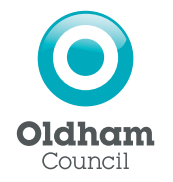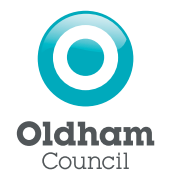Loading...
Early years
Good Level of Development - Reception Aged Children
Introduction
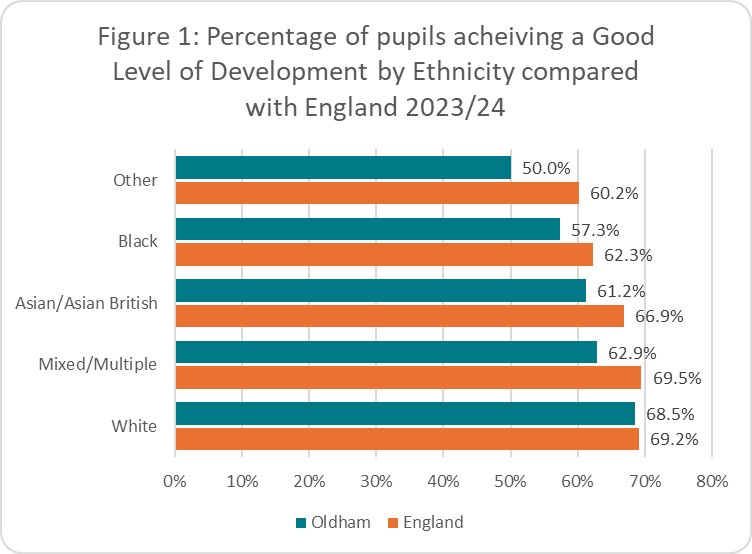
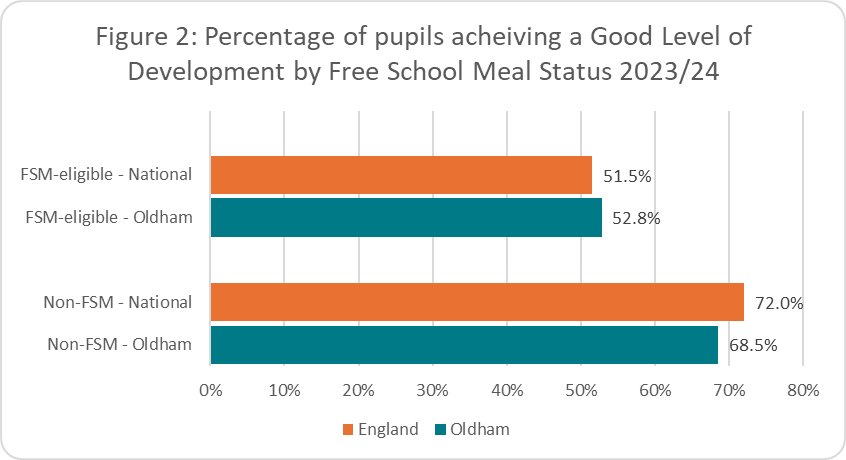
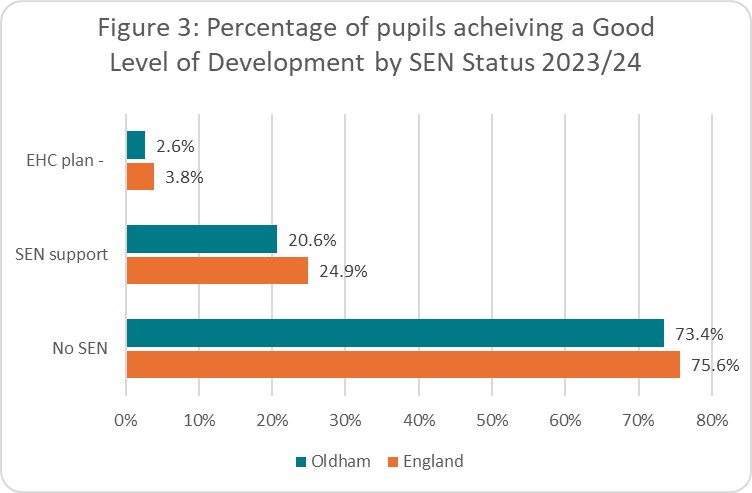
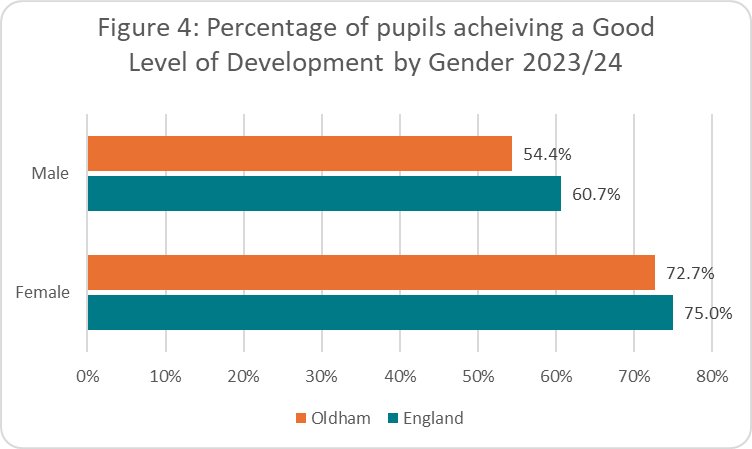
Source: Department for Education (DfE)
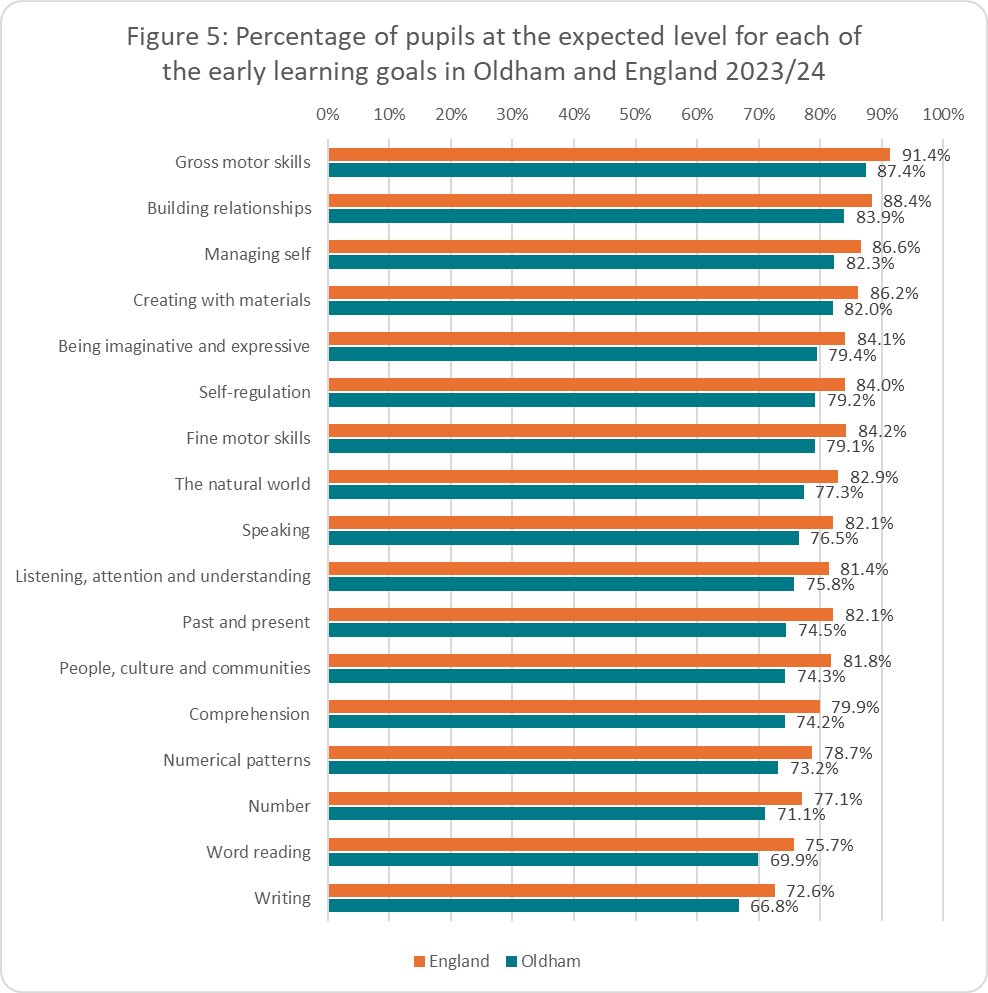
Source: Department for Education (DfE)
Conclusion
Early years foundation stage profile
Results for the 2023 to 2024 academic year at national and local authority level.
OHID's Child and Maternal Health Data Profile
For further data and information relating to Early Years Education
Introduction
Good Level of Development statistics report on teacher assessments of children’s development at the end of the early years foundation stage (EYFS), specifically the end of the academic year in which a child turns 5. This is typically the summer term of reception year. The assessment framework, or EYFS profile, consists of 17 early learning goals (ELGs) across 7 areas of learning.
There are 17 early learning goals that are assessed across seven specific areas of learning :
There are 17 early learning goals that are assessed across seven specific areas of learning :
Communication and language
Listening, attention and understanding
Speaking
Personal, social and emotional development
Self-regulation
Managing self
Building relationships
Physical development
Gross motor skills
Fine motor skills
Literacy
Comprehension
Word reading
Writing
Mathematics
Number
Numerical patterns
Understanding the world
Past and present
People, culture and communities
The natural world
Expressive arts and design
Creating with materials
Being imaginative and expressive
Children achieve the 'Good Level of Development (GLD)' if they are at the expected levels for the 12 Early Learning Goals within the 5 areas of learning relating to: communication and language; personal, social and emotional development; physical development; literacy; and mathematics.
Figures 1-4 below explore the percentage of children achieving a good level of development by various characteristics.
Listening, attention and understanding
Speaking
Personal, social and emotional development
Self-regulation
Managing self
Building relationships
Physical development
Gross motor skills
Fine motor skills
Literacy
Comprehension
Word reading
Writing
Mathematics
Number
Numerical patterns
Understanding the world
Past and present
People, culture and communities
The natural world
Expressive arts and design
Creating with materials
Being imaginative and expressive
Children achieve the 'Good Level of Development (GLD)' if they are at the expected levels for the 12 Early Learning Goals within the 5 areas of learning relating to: communication and language; personal, social and emotional development; physical development; literacy; and mathematics.
Figures 1-4 below explore the percentage of children achieving a good level of development by various characteristics.
- Ethnic disparities in GLD achievement are evident in both Oldham and national data. White pupils in Oldham (68.5%) perform closest to the national average, with just a 0.7 percentage point gap. However, larger disparities exist for other ethnic groups, particularly for children from Other ethnic groups (10.2 percentage points below national) and Mixed/Multiple ethnic groups (6.6 percentage points below). Asian/Asian British children in Oldham (61.2%) lag behind their national counterparts (66.9%) by 5.7 percentage points. These gaps suggest potential barriers related to language, cultural factors, or access to early years support for ethnic minority communities in Oldham.
- Oldham shows particular strength in supporting disadvantaged pupils, with FSM-eligible children achieving a GLD rate of 52.8%, which is 1.3 percentage points above the national average of 51.5%. However, non-FSM pupils in Oldham (68.5%) lag behind their national counterparts (72.0%) by 3.5 percentage points. Notably, Oldham has a narrower FSM achievement gap (15.7 percentage points) compared to the national gap (20.5 percentage points), suggesting more equitable outcomes between disadvantaged and non-disadvantaged pupils in Oldham.
- Children with SEN in Oldham show lower GLD achievement rates compared to national averages across all categories. Children receiving SEN support in Oldham have the largest gap, with just 20.6% achieving GLD compared to 24.9% nationally (a 4.3 percentage point difference). Children with Education, Health and Care (EHC) plans in Oldham have very low GLD achievement (2.6%) compared to the national figure of 3.8%. Even among children with no identified SEN, Oldham's rate (73.4%) is 2.2 percentage points below the national average (75.6%). These figures highlight the need for enhanced early intervention and support for children with additional needs in Oldham.
- Significant gender disparities exist in GLD achievement, with girls outperforming boys in both Oldham and nationally. In Oldham, 72.7% of girls achieve GLD compared to just 54.4% of boys, creating an 18.3 percentage point gender gap that exceeds the national gender gap by 4 percentage points. While Oldham's girls perform relatively close to the national average (2.3 percentage points below), Oldham's boys show a much larger gap of 6.3 percentage points below their national counterparts.




Source: Department for Education (DfE)
Figure 5 below provides a detailed comparison of Oldham's performance against the national average across all 17 individual Early Learning Goals (ELGs), sorted by Oldham's achievement rates from highest to lowest.
- Oldham performs below the national average across all 17 Early Learning Goals, with gaps ranging from 4.0 to 7.6 percentage points. Physical development, particularly gross motor skills (87.4%), represents Oldham's strongest area of achievement, though still below the national figure of 91.4%. Personal, social, and emotional development goals also show relatively strong performance, with building relationships at 83.9% and managing self at 82.3%.
- The largest performance gaps compared to national averages are in the "Understanding the World" domain, specifically "past and present" (7.6 percentage points below) and "people, culture and communities" (7.5 points below). This suggests children in Oldham may have fewer opportunities to develop cultural awareness and historical understanding.
- Literacy represents a challenging area, with writing having the lowest overall achievement rate (66.8%) compared to 72.6% nationally. Similarly, mathematics goals show significant gaps, with number concepts at 71.1% compared to 77.1% nationally.
- Overall, the pattern indicates stronger development in physical and social-emotional domains compared to cognitive and academic domains, suggesting potential focus areas for early years improvement initiatives in Oldham.

Source: Department for Education (DfE)
Conclusion
- Oldham's GLD data from 2023/24 shows some improvement compared to 2021/22, with particular strengths in supporting disadvantaged pupils. The authority has improved at a faster rate than the national average and most GM neighbours, narrowing the gap to national performance.
- While challenges remain, particularly for male pupils and some ethnic minority groups, the consistent improvement trend suggests that strategies implemented over this period are having a positive impact. Oldham has improved from 7th to 6th place in the Greater Manchester rankings, and if the current improvement rate continues (3.8 percentage points over three years), it could further narrow the gap to national averages and improve its regional standing.
- The most significant finding is Oldham's strength in supporting FSM-eligible pupils, where it outperforms the national average – an important achievement given the link between socioeconomic disadvantage and early development outcomes. This suggests Oldham has developed effective approaches for supporting its most vulnerable children that could be applied more broadly to other demographic groups showing lower performance.
Early years foundation stage profile
Results for the 2023 to 2024 academic year at national and local authority level.
OHID's Child and Maternal Health Data Profile
For further data and information relating to Early Years Education
